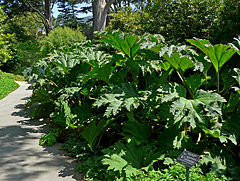Gunnera tinctoria
| Gunnera tinctoria subsp. var. | Gunnera chilensis, Gunnera scabra | |||||||||||||||||||||||||||||||||||||||||||||||||||||||
|---|---|---|---|---|---|---|---|---|---|---|---|---|---|---|---|---|---|---|---|---|---|---|---|---|---|---|---|---|---|---|---|---|---|---|---|---|---|---|---|---|---|---|---|---|---|---|---|---|---|---|---|---|---|---|---|---|

|
|
| ||||||||||||||||||||||||||||||||||||||||||||||||||||||
| ||||||||||||||||||||||||||||||||||||||||||||||||||||||||
Gunnera tinctoria, the Chilean rhubarb, is a plant species native to southern Chile and neighbour zones in Argentina. It is a large-leaved perennial plant that grows up to two metres tall. It is introduced in large parts of the world as an ornamental and edible plant. In some countries (for instance New Zealand and Ireland) it has spread from gardens and is becoming a weed problem.
Gunnera tinctoria is a giant, clump-forming herbaceous perennial. The leaves can grow up to 2.5m across. It has erect spikes of cone-shaped inflorescences (to 1m) from spring to early summer, with small flowers. The fruit is orange. The number of seeds is estimated from 80.000 per seedhead to 250.000 per plant. In parts of New Zealand the Chilean rhubarb has become a recognised pest plant.
| Standard Cyclopedia of Horticulture |
|---|
|
Gunnera chilensis, Lam. (G. scabra, Ruiz & Pav.). Not so robust, the lvs. smaller and less spiny, and the fl.-spikes less tall: fls. reddish.—Thrives in drier soil. Var. major, Hort., is a very strong-growing form.
|
Cultivation
Propagation
Pests and diseases
Varieties
Gallery
References
External links
- w:Gunnera tinctoria. Some of the material on this page may be from Wikipedia, under the Creative Commons license.
- Gunnera tinctoria QR Code (Size 50, 100, 200, 500)

